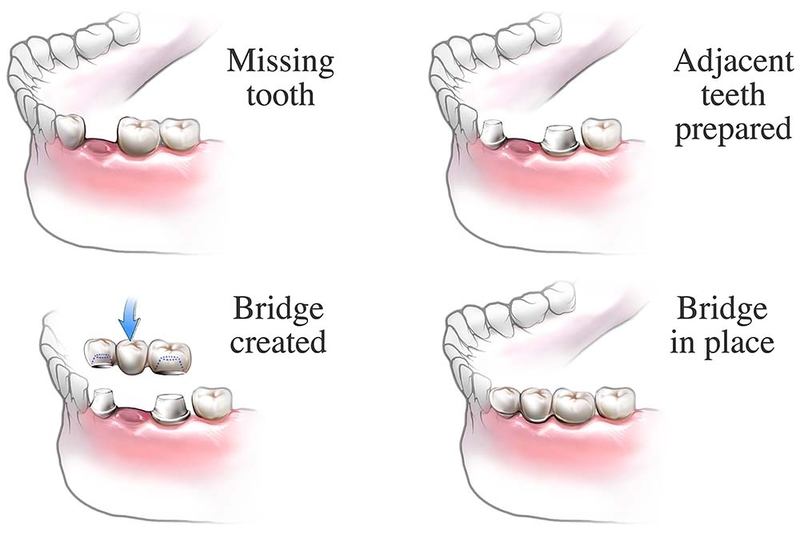
Dental bridges stay securely in place through a combination of design, structure, and modern dental materials. Comprising artificial teeth (pontics) and natural teeth or implants (abutment teeth), the bridge is anchored using dental cement and adhesive materials. This creates stability, allowing individuals to eat, speak, and smile confidently. The adjacent teeth are prepared to support the bridge, and with proper care, this restoration offers long-lasting function and aesthetics, making it an excellent solution for replacing missing teeth. Whether considering a bridge or satisfying curiosity, this article unveils the secrets behind this dental marvel.

How Do Dental Bridges Stay in Place?
Dental bridges are a common solution for replacing missing teeth and restoring a person’s smile. But how exactly do dental bridges stay in place? In this article, we will explore the different methods used to secure dental bridges and ensure they remain stable and functional.
The Importance of Dental Bridges
Dental bridges play a crucial role in restoring oral health and function for individuals who have lost one or more teeth. Not only do they improve the appearance of the smile, but they also help maintain proper alignment of the surrounding teeth and prevent potential dental issues such as shifting and bite problems. Dental bridges offer a durable and long-lasting solution, and understanding how they stay in place is essential for anyone considering this treatment option.
Traditional Dental Bridges:
- Description: Traditional bridges involve a pontic (artificial tooth) anchored by dental crowns on adjacent abutment teeth.
- Procedure: Abutment teeth are prepared by removing enamel, and crowns are cemented, holding the pontic in place.
- Success Criteria: Relies on the strength of abutment teeth; they must be healthy and stable to support the bridge effectively.
- Assessment: Dentist evaluates abutment teeth, may recommend additional treatments like fillings or root canal therapy.
Implant-Supported Dental Bridges:
- Overview: This option uses dental implants surgically placed in the jawbone to support the bridge, ideal for multiple missing teeth.
- Foundation: Dental implants act as artificial tooth roots, providing a stable base for the bridge.
- Integration: Implants fuse with the jawbone through osseointegration, ensuring a permanent and secure support system.
- Advantages: Offers improved stability, enhanced chewing ability, and helps preserve jawbone health.
Factors Influencing Bridge Stability:
- Oral Hygiene: Proper oral care, including brushing, flossing, and regular check-ups, is crucial to maintain abutment teeth health and prevent gum disease.
- Material Quality: The stability of the bridge depends on the quality of materials used. Porcelain or ceramic materials ensure durability and resistance to wear.
- Dentist’s Skill: The expertise of the dentist influences the success of bridge placement. Accurate fitting and precise cementation are vital for optimal stability and longevity.
Conclusion
Dental bridges are an effective solution for replacing missing teeth and restoring oral function. Whether secured using traditional crowns or dental implants, bridges offer a stable and long-lasting solution. By understanding the methods used to keep dental bridges in place and following proper oral care practices, individuals can enjoy the benefits of a beautiful and functional smile for years to come. Remember to consult with your dentist to determine the most suitable option for your specific needs.
Key Takeaways: How Do Dental Bridges Stay in Place?
- Dental bridges are held in place by dental crowns on either side of the gap.
- These crowns are cemented onto the teeth adjacent to the gap.
- The bridge itself is custom-made to fit snugly and securely in the gap.
- The bridge is made from materials such as porcelain or metal alloy for strength.
- Proper oral hygiene and regular dental check-ups are important to maintain the bridge’s stability.
Frequently Asked Questions
How are dental bridges held in place?
Dental bridges are held in place by a combination of factors. Firstly, the adjacent teeth on either side of the gap are prepared by removing a small amount of enamel. These teeth, known as abutment teeth, act as anchors for the bridge. The bridge consists of two crowns that are cemented onto the abutment teeth, with a false tooth, or pontic, in between. The crowns and pontic are usually made of porcelain or a combination of materials.
In addition to the abutment teeth, dental bridges may also be secured using dental implants. Implants are artificial tooth roots that are surgically placed into the jawbone. These implants provide a stable foundation for the bridge and help distribute the biting forces evenly. The choice between using abutment teeth or implants depends on various factors, such as the health of the adjacent teeth and the bone density in the jaw.
What is the role of dental cement in holding the bridge in place?
Dental cement plays a crucial role in holding the bridge in place. Once the bridge is properly fitted onto the abutment teeth or implants, dental cement is used to secure it in position. The cement forms a strong bond between the bridge and the natural teeth or implants, ensuring stability and preventing any movement.
The dental cement used for bridges is specifically designed for this purpose. It is a durable material that can withstand the forces of chewing and biting. The cement is applied to the inner surface of the crowns and pontic, and then the bridge is carefully positioned and pressed onto the abutment teeth or implants. Excess cement is removed, and any final adjustments are made to ensure a comfortable fit.
Can dental bridges become loose over time?
In rare cases, dental bridges can become loose over time. The most common cause of a loose bridge is the natural wear and tear that occurs with regular use. Over time, the cement used to hold the bridge in place may weaken or deteriorate, causing the bridge to become less stable. Additionally, if there is underlying gum disease or bone loss, it can affect the stability of the bridge.
If you notice any signs of a loose bridge, such as movement or discomfort, it is important to see your dentist as soon as possible. They can evaluate the bridge and recommend the appropriate treatment, which may involve re-cementing the bridge or exploring other options, such as a new bridge or dental implants.
How long do dental bridges typically last?
The lifespan of a dental bridge can vary depending on various factors, such as oral hygiene practices, overall oral health, and the materials used for the bridge. On average, dental bridges can last between 5 to 15 years or even longer with proper care.
To extend the lifespan of your bridge, it is important to maintain good oral hygiene habits. This includes brushing twice a day, flossing daily, and visiting your dentist regularly for check-ups and cleanings. Avoiding habits like biting on hard objects or using your teeth as tools can also help prevent damage to the bridge.
Can dental bridges be replaced if necessary?
Yes, dental bridges can be replaced if necessary. If your existing bridge becomes damaged, loose, or no longer fits properly, your dentist can assess the situation and recommend the appropriate course of action. In some cases, the bridge may be able to be repaired. However, if the damage is significant or the bridge is no longer salvageable, a new bridge may need to be fabricated.
When replacing a dental bridge, your dentist will take new impressions of your teeth and order a new bridge that is customized to fit your mouth. The process may involve removing the old bridge, preparing the abutment teeth or implants, and then fitting the new bridge into place. Your dentist will ensure that the new bridge is securely held in place and that it provides a comfortable and functional restoration for your missing teeth.
Help! How Do I Keep My Dental Bridges From Falling Out?
Final Summary: How Dental Bridges Stay in Place
Dental bridges stay securely in place by utilizing abutment teeth on each side of the gap. These devices provide both aesthetic appeal and functionality, allowing for confident eating, speaking, and smiling. The stability is reinforced by dental cement or adhesive, forming a robust bond between artificial and natural teeth. This adhesive withstands the forces of biting and chewing, ensuring long-lasting support. With proper oral care, including regular check-ups, dental bridges offer enduring benefits in terms of both aesthetics and functionality. Choosing a dental bridge means saying farewell to gaps and embracing a healthy, confident smile for years to come.
Call or Book appointment online
:Ace Dental Care Alpharetta office: 678-562-1555 - Book Now
Ace Dental Care Norcross office: 770-806-1255 - Book Now
Disclaimer
This blog post was generated by artificial intelligence. The content of this post may not be accurate or complete, and should not be relied upon as a substitute for professional advice. If you have any questions about the content of this post, please contact us.
We are constantly working to improve the accuracy and quality of our AI-generated content. However, there may still be errors or inaccuracies. We apologize for any inconvenience this may cause.





